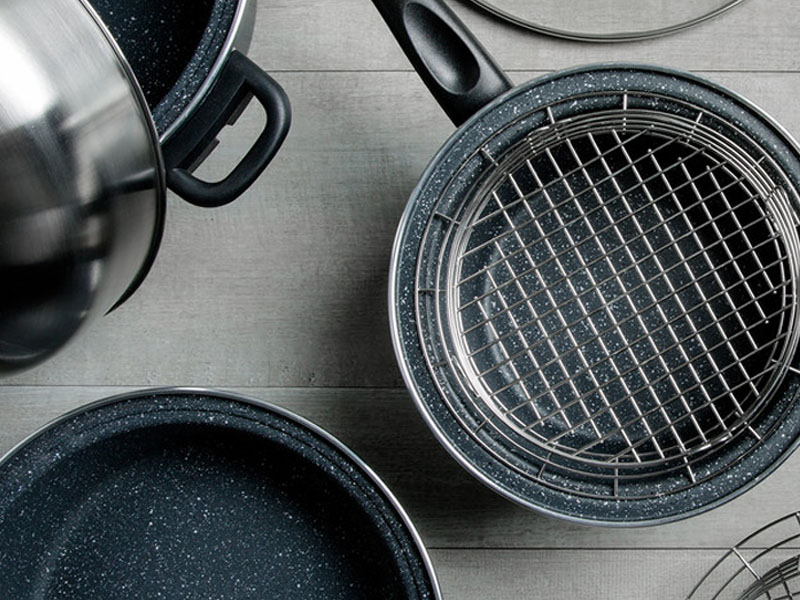When it comes time to build your culinary collection, it pays to know what pieces you need in your arsenal. And just as a skilled surgeon wouldn’t rely on the wrong materials, professional chefs know which types of cookware result in the finest cuisine.
From copper to cast iron, stainless steel to aluminum, there are advantages and disadvantages alike when it comes to each material. This guide will give you the nitty-gritty on which you need, when you need them, and — most importantly — why.
Aluminum:
Check the oldest stuff in your kitchen — you know, the pieces that came along with you after college, those reliable old pots and pans that have somehow survived every move. They’re likely to be made of aluminum, probably anodized aluminum if they’ve made it this far. While the likeliest material to age poorly, when electro-chemically hardened, anodized aluminum can last a long time. It’s not the quickest-heating material, but it’s a handier heat conductor than stainless steel and can be much stronger than its weight belies. It’s also reactive, which is an indicator that it displaces heat evenly, but also can mean it will change the flavor of alkalines or acids. So while you can’t cook absolutely everything in these pans, they’re still great for day to day.
Summary: If you’re buying aluminum cookware, look for anodized pieces, and avoid cooking tomato sauces with them. Pros: Perfect thermal conductivity, lightweight Cons: Reactive, can warp more easily
Cast Iron:
Cast iron is best known for its heft, as well as its utility for long-term flavor building. It does distribute heat efficiently, and is non-stick by nature, but it’s another reactive material and doesn’t do the best with acids. While some say it’s more difficult to maintain, the cast iron skillet is a cult favorite. This is probably due to the beautiful sear you can get with these pieces, as well its utility when it comes to baking. This is due to its ability to go from stovetop to oven, making it a useful tool for those who love making everything from scratch — for example, it’s an easy vessel to cook a pizza — crust and all. A cast iron piece of cookware is an incredibly cost-effective investment as well, no matter how much you spend on it, as they can last a hundred years with proper care and seasoning.
Summary: Cast iron is a classic that’s incredibly flexible in its uses: it also lasts a lifetime. Pros: Perfect thermal conductivity Cons: Reactive, requires extra maintenance
Ceramics:
Most ceramic cookware isn’t purely ceramic — often it’s enameled cast iron, as in the case of dutch ovens. This makes using cast iron easy to clean, as well as making it nonreactive. Being the opposite of reactive metals, nonreactive materials can hold hot spots and cook less evenly, but they never impact the flavors of the food you’re cooking. Ceramic cookware also includes earthenware and stoneware, which are entirely ceramic. The difference between earthenware and stoneware is the firing temperature, which makes stoneware a little hardier, as it’s made in a hotter heat. Ceramics are popular with Martha Stewart types, due to its ability to come in a variety of colors and glazes, which make serving meals beautiful even without plating.
Summary: Collectible beauties, ceramic cookware pieces are nonreactive and easy to clean. Pros: Gorgeous, nonreactive, easy to clean Cons: Chips easily, less durable
Copper:
Incredibly trendy, the bright gleam of copper can make any kitchen look gourmet. Its thermal conductivity is top notch, lasting for decades’ worth of meals to come. It’s incredibly sensitive, heating and cooling quickly for the ultimate control in your cooking. It’s reactive, so it can impart a metallic taste unless substituted with a stainless steel or tin lining. Copper must be hand-dried, but is worth the love and care that it requires. Some have a smooth appearance, while some have a hammered look that descends from the days when all pots and pans were hand-crafted. It’s usually just an aesthetic addition now, so it’s up to you which look you want — the hammered pieces are not necessarily better, just beautifully textured.
Summary: Copperware makes for gorgeous showpieces, whose utility best suits detail-oriented chefs. Pros: Perfect thermal conductivity, good-looking Cons: Reactive, requires extra maintenance
Stainless Steel:
Nonreactive (we know what that means now, right?), durable and dishwasher safe, stainless steel is a commonly-used kitchen material — and for good reason. We all know stainless steel to be easy to clean, good quality, and good-looking. It gleams in the most high-end kitchens around, polished to a gorgeous shine. To amp up its heat distribution, you can always try steel cookware made with an aluminum or copper core, which will come with a higher price but a more perfect cooking surface. Stainless steel cookware can also vary wildly in its thickness. The thinner the pan, the lower the quality, but if you invest in a good set then they’re sure to last a long time — not so long as cast iron, but a 50-year lifespan is nothing to sneeze at. It’s generally resistant to scratches, and pure stainless steel does not impact any flavor to its food other than that of whatever you’re cooking.
Summary: Stainless steel is a classic, with nonreactive qualities and the capacity for high quality. Pros: Dishwasher safe, nonreactive Cons: Imperfect heat transfer/conductivity


